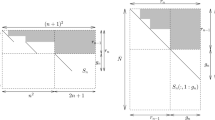Abstract
This paper explores the quality of polynomial interpolation approximations over the sphere S r−1⊂R r in the uniform norm, principally for r=3. Reimer [17] has shown there exist fundamental systems for which the norm ‖Λ n ‖ of the interpolation operator Λ n , considered as a map from C(S r−1) to C(S r−1), is bounded by d n , where d n is the dimension of the space of all spherical polynomials of degree at most n. Another bound is d n 1/2(λavg/λmin )1/2, where λavg and λmin are the average and minimum eigenvalues of a matrix G determined by the fundamental system of interpolation points. For r=3 these bounds are (n+1)2 and (n+1)(λavg/λmin )1/2, respectively. In a different direction, recent work by Sloan and Womersley [24] has shown that for r=3 and under a mild regularity assumption, the norm of the hyperinterpolation operator (which needs more point values than interpolation) is bounded by O(n 1/2), which is optimal among all linear projections. How much can the gap between interpolation and hyperinterpolation be closed?
For interpolation the quality of the polynomial interpolant is critically dependent on the choice of interpolation points. Empirical evidence in this paper suggests that for points obtained by maximizing λmin , the growth in ‖Λ n ‖ is approximately n+1 for n<30. This choice of points also has the effect of reducing the condition number of the linear system to be solved for the interpolation weights. Choosing the points to minimize the norm directly produces fundamental systems for which the norm grows approximately as 0.7n+1.8 for n<30. On the other hand, ‘minimum energy points’, obtained by minimizing the potential energy of a set of (n+1)2 points on S 2, turn out empirically to be very bad as interpolation points.
This paper also presents numerical results on uniform errors for approximating a set of test functions, by both interpolation and hyperinterpolation, as well as by non-polynomial interpolation with certain global basis functions.
Similar content being viewed by others
References
D.L. Berman, On a class of linear operators, Dokl. Akad. Nauk SSSR 85 (1952) 13-16 (in Russian); Math. Reviews 14, 57.
I.K. Daugavet, Some applications of the Marcinkiewicz-Berman identity, Vestnik Leningrad Univ. Math. 1 (1974) 321-327.
P.J. Davis, Interpolation and Approximation(Blaisdell, New York, 1963).
J. Fliege and U. Maier, A two-stage approach for computing cubature formulae for the sphere, Ergebnisberichte Angewandte Mathematik 139T, Universität Dortmund, Fachbereich Mathematik, Universität Dortmund, Germany (September 1996).
J. Fliege and U. Maier, The distribution of points on the sphere and corresponding cubature formulae, IMA J. Numer. Anal. 19 (1999) 317-334; http://www.mathematik.uni-dortmund.de/ lsx/fliege/nodes.html.
W. Freeden, T. Gervens and M. Schreiner, Constructive Approximation on the Sphere(Clarendon Press, Oxford, 1998).
M. Ganesh, I. Graham and J. Sivaloganathan, A pseudospectral three-dimensional boundary integral method applied to a nonlinear model problem from finite elasticity, SIAM J. Numer. Anal. 31 (1994) 1378-1414.
M. Ganesh, I. Graham and J. Sivaloganathan, A new spectral boundary integral collocation method for three-dimensional potential problems, SIAM J. Numer. Anal. 35 (1998) 778-805.
T.H. Gronwall, On the degree of convergence of Laplace's series, Trans. Amer. Math. Soc. 15 (1914) 1-30.
K. Jetter, J. Stöckler and J.D. Ward, Error estimates for scattered data interpolation on spheres, Math. Comp. 68 (1999) 733-747.
Q.T. Le Gia and I.H. Sloan, The uniform norm of hyperinterpolation on the unit sphere in an arbitrary number of dimensions, Constructive Approximation 17 (2001) 249-265; http://link. springer.de/link/service/journals/00365/contents/00/10025/.
A.S. Lewis and M.L. Overton, Eigenvalue optimization, ACTA Numerica (1996) 149-190.
C. Müller, Spherical Harmonics, Lecture Notes in Mathematics, Vol. 17 (Springer, Berlin/New York, 1966).
M.L. Overton, Large-scale optimization of eigenvalues, SIAM J. Optimization 2 (1992) 88-120.
E. Polak, Optimization: Algorithms and Consistent Approximations(Springer, New York, 1997).
M. Reimer, Interpolation on the sphere and bounds for the Lagrangian square sums, Resultate Math. 11 (1987) 144-166.
M. Reimer, Constructive Theory of Multivariate Functions(BI Wissenschaftsverlag, Mannheim/Wien/Zürich, 1990).
M. Reimer, Quadrature rules for the surface integral of the unit sphere based on extremal fundamental systems, Math. Nachr. 169 (1994) 235-241.
M. Reimer, The average size of certain Gram-determinants and interpolation on non-compact sets, in: Multivariate Approximation and Splines(Mannheim, 1966), International Series on Numerical Mathematics, Vol. 125 (Birkhauser, Basel, 1998) pp. 235-244.
M. Reimer, Hyperinterpolation on the sphere at the minimal projection order, J. Approx. Theory 104 (2000) 272-286.
M. Reimer and B. Sündermann, A Remez-type algorithm for the calculation of extremal fundamental systems on the sphere, Computing 37 (1986) 43-58.
I.H. Sloan, Polynomial interpolation and hyperinterpolation over general regions, J. Approx. Theory 83 (1995) 238-254.
I.H. Sloan and R.S. Womersley, The uniform error of hyperinterpolation on the sphere, in: Advances in Multivariate Approximation, eds. W. Haußmann, K. Jetter and M. Reimer, Mathematical Research, Vol. 107 (Wiley-VCH, Berlin, 1999) pp. 289-306.
I.H. Sloan and R.S. Womersley, Constructive polynomial approximation on the sphere, J. Approx. Theory 103 (2000) 91-118.
G. Szegö, Orthogonal Polynomials, 4th ed., American Mathematical Society Colloquium Publications, Vol. 23 (Amer. Math. Soc., Providence, RI, 1975).
D.L. Williamson, J.B. Brake, J.J. Hack, R. Jakob and P.N. Swarztrauber, A standard test set for numerical approximations to the shallow water equations in spherical geometry, J. Comput. Phys. 102 (1992) 211-224.
R.S. Womersley, A continuous minimax problem for calculating minimum norm polynomial interpolation points on the sphere, ANZIAM J. 42 (E) (2000) C1536-C1557; http://jamsb.austms. org.au/V42contents.html.
Author information
Authors and Affiliations
Rights and permissions
About this article
Cite this article
Womersley, R.S., Sloan, I.H. How good can polynomial interpolation on the sphere be?. Advances in Computational Mathematics 14, 195–226 (2001). https://doi.org/10.1023/A:1016630227163
Issue Date:
DOI: https://doi.org/10.1023/A:1016630227163



